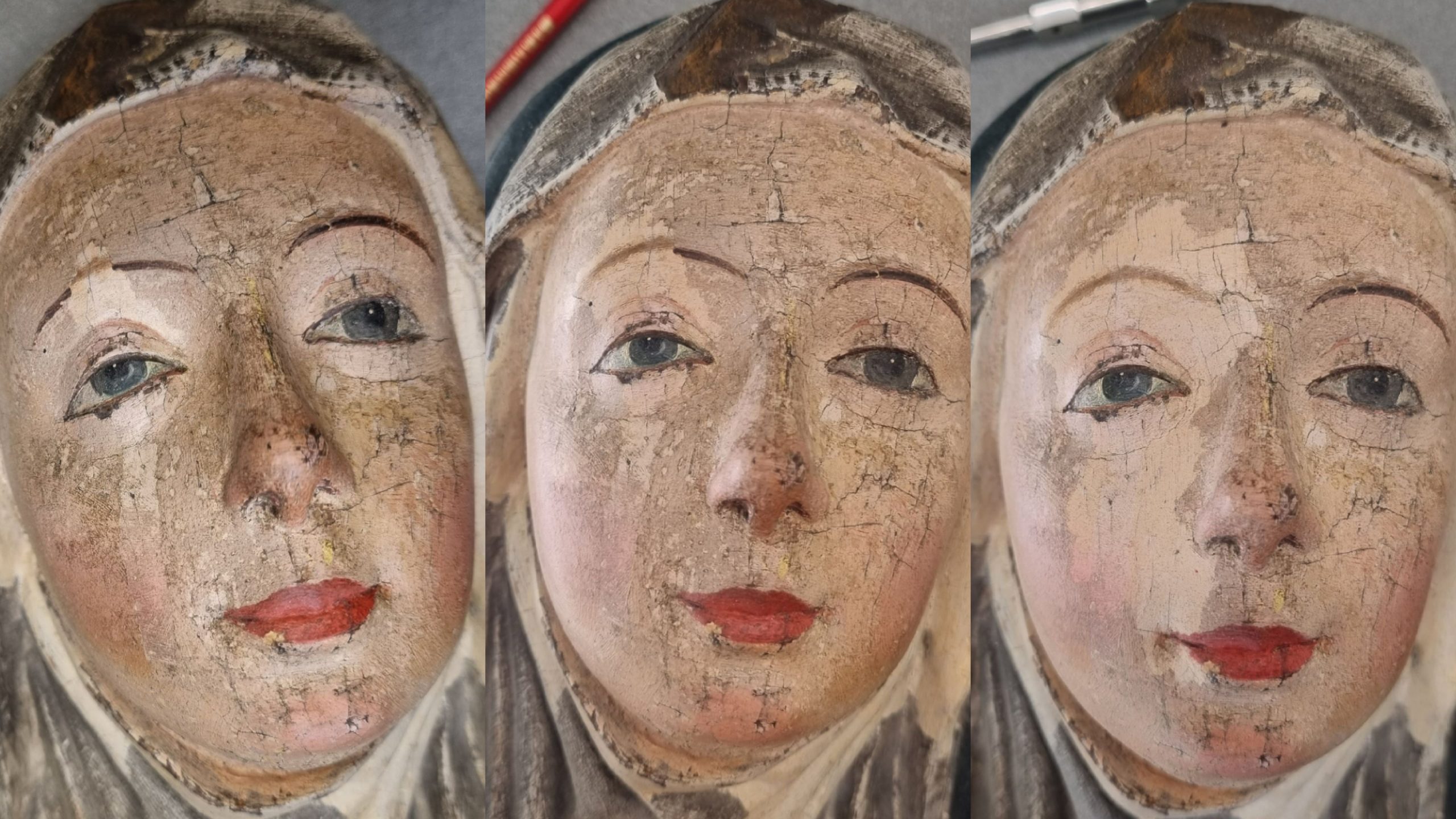


The sculpture had not been cleaned and later paint layers had not been removed in the course of any of the previous restoration works. The sculpture is exceedingly grimy, and areas of cleaning tests, prophylactic facings, and samples of overpaint uncoverings break up the whole, which is uneven as it is. For instance, a sample area of overpaint removal ran across the right side of the Virgin Mary’s face, from which 3 paint layers could clearly be differentiated: the 15th century original, the 17th century tempera layer, and the 19th century oil paint layer (photo 4). After the precise mapping of the sculpture’s condition, the revealing of the original layers and the restoration of the sculpture’s visual integrity was set as the goal of the conservation. Thus, the exceedingly time-consuming first stage of work became the removal of secondary paint layers, which can only be done mechanically using a scalpel under magnification provided by an optical microscope (photo 5).


The first stage of work and the removal of the overpaint from the 17th century
In drawing up the conservation plan, the documentation of the overpainting, which had been carried out using tempera paints in 1625, was set as an objective. This means that the conservators try to remove the coats of overpainting layer by layer wherever possible. In the course of the work, it turned out that the tempera layer, which had been applied to the original layer in the 17th century, can almost completely be cleaned out from beneath the thick and uneven layer of oil paint. There are losses in many places, but the overall picture is entirely readable. Compared to the original, fine details have been lost by applying the new paint layer. Yet the 17th century overpainting nevertheless conforms to the original to a certain extent, which can no longer be said about the robustly executed 19th century overpainting. For instance, the arch of the eyebrow follows the arch of the original eyebrow (photo 6), the eye colour has gone from blue to a greyer tone, the colour of the lips is lighter, and the cheeks are just as pink as they previously were.
The comprehensive documentation and visual recording of the 17th century paint layer gave the conservator the (mental) assurance to remove this historical overpainting and thereby to reveal the sculpture’s original paint layer (photo 7). Several arguments spoke in favour of removal. First of all, the conservation concept – to reveal the 15th century layer as was done in the course of previous conservation work (in the 1980s) on other sculptures of the altarpiece. Secondly, the bond between the 17th century painting layer and the original, lower layer was exceedingly weak in some places. An uneven layer of varnish and dirt, which was very thick in some areas, drastically decreased the adhesion between these two layers of paint. As a result, several losses of the 17th century paint layer occurred in the course of removing the 19th century layer since the top layer stuck firmly to the 17th century one and took the lower layer with it.
The previously mentioned uneven layer of varnish and dirt also made it more difficult to clean the original paint layer. An uneven, yellowed layer of varnish coating the original emerged in several areas from beneath the 17th century paint layer, which was quite easily removed. Since the original surface itself is so delicate and the removal of the layer of patina seemed arbitrary, the use of solvents was out of the question. For this reason, the varnish layer also had to be removed or thinned out mechanically using a scalpel.Maarja’s palm also offered a nice surprise. While removing the top layers of paint, a very nice detail came out: bluish blood vessels (photo 8 and 9).




